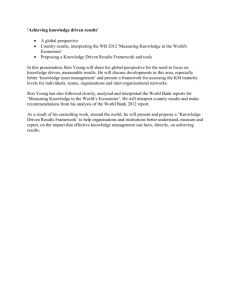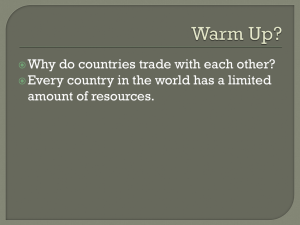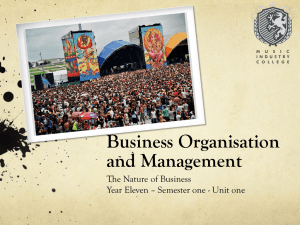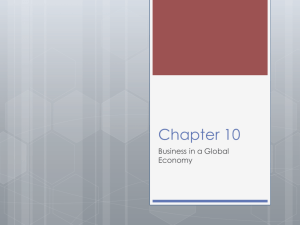WEEK 4: THE BUSINESS CONTEXT
advertisement
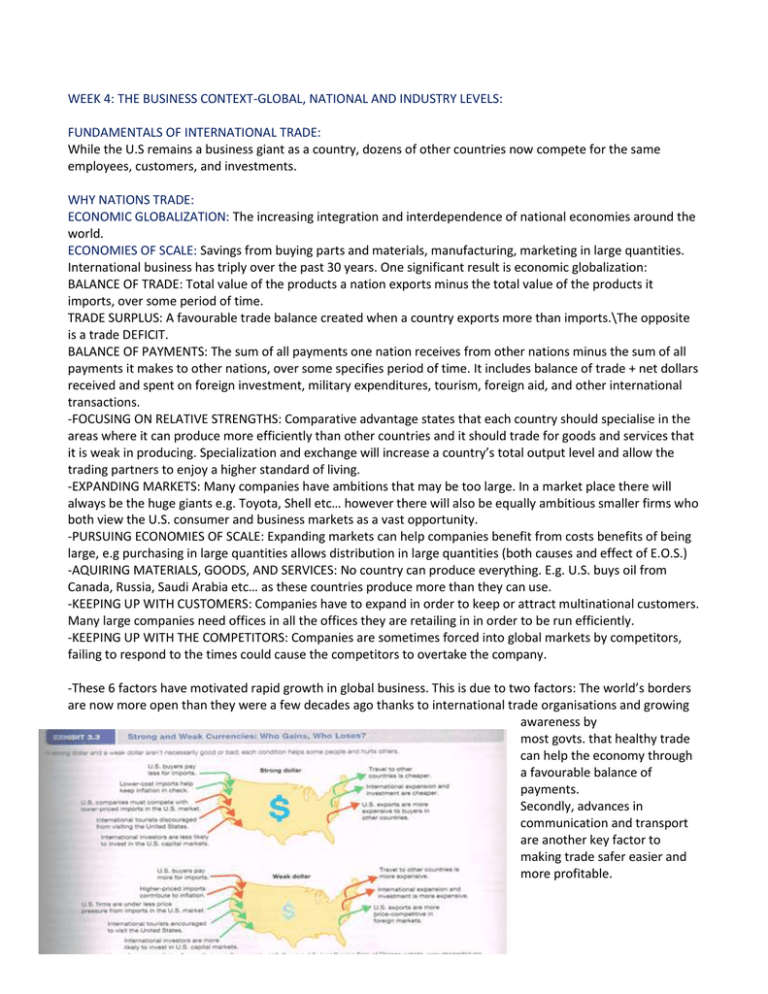
WEEK 4: THE BUSINESS CONTEXT-GLOBAL, NATIONAL AND INDUSTRY LEVELS: FUNDAMENTALS OF INTERNATIONAL TRADE: While the U.S remains a business giant as a country, dozens of other countries now compete for the same employees, customers, and investments. WHY NATIONS TRADE: ECONOMIC GLOBALIZATION: The increasing integration and interdependence of national economies around the world. ECONOMIES OF SCALE: Savings from buying parts and materials, manufacturing, marketing in large quantities. International business has triply over the past 30 years. One significant result is economic globalization: BALANCE OF TRADE: Total value of the products a nation exports minus the total value of the products it imports, over some period of time. TRADE SURPLUS: A favourable trade balance created when a country exports more than imports.\The opposite is a trade DEFICIT. BALANCE OF PAYMENTS: The sum of all payments one nation receives from other nations minus the sum of all payments it makes to other nations, over some specifies period of time. It includes balance of trade + net dollars received and spent on foreign investment, military expenditures, tourism, foreign aid, and other international transactions. -FOCUSING ON RELATIVE STRENGTHS: Comparative advantage states that each country should specialise in the areas where it can produce more efficiently than other countries and it should trade for goods and services that it is weak in producing. Specialization and exchange will increase a country’s total output level and allow the trading partners to enjoy a higher standard of living. -EXPANDING MARKETS: Many companies have ambitions that may be too large. In a market place there will always be the huge giants e.g. Toyota, Shell etc… however there will also be equally ambitious smaller firms who both view the U.S. consumer and business markets as a vast opportunity. -PURSUING ECONOMIES OF SCALE: Expanding markets can help companies benefit from costs benefits of being large, e.g purchasing in large quantities allows distribution in large quantities (both causes and effect of E.O.S.) -AQUIRING MATERIALS, GOODS, AND SERVICES: No country can produce everything. E.g. U.S. buys oil from Canada, Russia, Saudi Arabia etc… as these countries produce more than they can use. -KEEPING UP WITH CUSTOMERS: Companies have to expand in order to keep or attract multinational customers. Many large companies need offices in all the offices they are retailing in in order to be run efficiently. -KEEPING UP WITH THE COMPETITORS: Companies are sometimes forced into global markets by competitors, failing to respond to the times could cause the competitors to overtake the company. -These 6 factors have motivated rapid growth in global business. This is due to two factors: The world’s borders are now more open than they were a few decades ago thanks to international trade organisations and growing awareness by most govts. that healthy trade can help the economy through a favourable balance of payments. Secondly, advances in communication and transport are another key factor to making trade safer easier and more profitable. -Foreign exchange is the exchange of goods through the exchange of currencies, (i.e. the conversion of one currency to make it equivalent to the other) EXCHANGE RATE: The rate at which the money of one country is traded for the money of another. FLOATING EXCHANGE RATE SYSTEM: The currency’s value or price fluctuates in response to the forces of global supply and demand. CONFLICTS OF INTERNATIONAL TRADE: FREE TRADE: International trade unencumbered by restrictive measures. Free trade can be a threat to the middle class who would not be able to afford some products if it were not for government subsidies as free trade makes it too easy for companies to exploit workers around the world by pitting them against a race where production move to the country with the fewest restrictions and lowest wages. GOVERNMENT INTERVENTION IN INTERNATIONAL TRADE: PROTECTOINISM: Government policies aimed at shielding a country’s industries from foreign competition. /However some protectionist actions could indirectly hurt the groups they were intended to help E.g.s of INTERVENTION: -TARIFFS: Taxes, surcharges or duties levied against imported goods. Can be done to raise revenue, restrict trade, or punish other countries for disobeying international trade laws. -QUOTAS (import quotas): limits placed on the quantity of imports a nation will allow for a specific product -EMBARGO: A total ban in trade with a particular nation (a sanction) or of a particular product. -RESTRICTIVE IMPORT STANDARDS: Can assist domestic producers by establishing restrictive standards, e.g. requiring a special license for doing certain businesses making it difficult for foreign companies to obtain such licences. -EXPORT SUBSIDIES: A form of financial assistance in which producers receive enough money from the government to allow them to lower their prices in order to compete more effectively in the global market. -ANTI-DUMPING MEASURES: Practice of selling large quantities of a product at a price lower than the cost of production or below what the company would charge in its home market is called dumping. This tactic is used to try to win foreign customers or reduce product surpluses. If the domestic producer can demonstrate the low cost imports are damaging its business, most governments will seek compensation on behalf through international trade organisations. -SANCTIONS: Politically motivated EMBARGOES that revoke a country’s normal trade relations status; they are used as forceful alternatives short of war. Sanction can include, foreign-assistance reductions and cut-offs, trade limitations etc… INTERNATIONAL TRADE ORGANISATIONS: With international trade such a huge part of the world’s economies, organisations that establish trading rules, resolve disputes, and promote trade play an important role in global business. ORGANIZATIONS FACILITATING INTERNTIONAL TRADE: Governments around the world have established a number of important agreements and organizations that address trading issues, including the WTO, ITF and World Bank. TRADING BLOCKS: Organisations of nations that remove barriers to trade among their members and that establish uniform barriers to trade with non-member nations. THE GLOBAL BUSINESS ENVIRONMENT: CULTURE: A shred system of symbols, beliefs, attitudes, values, expectations, and norms for behaviour. -Ignorance of or indifference to cultural differences is a common cause of communication breakdowns in international affairs. STEREOTYPING: Assigning a wide range of generalized attributes which are often superficial or even false, to an individual based on his or her membership in a particular culture or social. ETHNOCENTRISM: Judging all other groups according to the standards, behaviours and customs of one’s own group. COMPANIES MUST: -BE ALERT TO THE OTHER PERSON’S CUSTOMS: Expect people to have different values, beliefs etc... -DEAL WITH THE INDIVIDUAL: Don't stereotype the other person, regard the person as an individual -ADAPT YOUR STYLE TO THE OTHER PERSON'S: If the other person appears to be direct and straightforward, follow suit. (follow the others persons behavioural characteristics) -CLARIFY YOUR INTENT AND MEANING: Don't judge peoples body language/characteristics, it could cause misunderstandings. -SHOW RESPECT: Respect other cultures-through gestures, eye contact, social customs and other actions. LEGAL DIFFERENCES IN THE GLOBAL BUSINESS ENVIRONMENT: Differences in national legal systems are sometimes not as obvious as cultural differences, but they can have a profound effect on international business efforts. CIVIL LAW SYSTEMS: short and simple business contracts THEORECTIVAL LAW SYSTEMS: based on religious principles, predominates in countries such as Iran an Pakistan COMMON LAW: based on tradition, custom and judicial interpretation IN AMERICA: Foreign Corrupt Practices Act (FCPA) deals with making sure companies don't pay governments bribes and interact in corrupt practices which could weaken trust in government, raise prices for customers by inflating business costs, and present security risks. FORMS OF INTERNATIONAL BUSINESS ACTIVITY: -IMPORTING: Purchasing goods or services from another country and bringing them into one's own country. -EXPORTING: Selling and shipping goods or services to another country. Allows a company to access foreign markets. In most cases, the firms financial exposure is limited to the costs of researching the market, advertising, and establishing a direct sales and distribution system. A variety of intermediaries is needed to help distribute the products across the different countries. INTERNATIONAL LICENSING: LICENSING: Agreement to produce and market another company's product in exchange for a royalty or fee. Low up-front costs are an attractive aspect of international licensing. Licensing agreements are not restricted to international business, products can be licensed to other companies in a domestic market. INTERNATIONAL FRANCHISING: When a business sells the right to use a business system, including brand names, business processes, trade secrets etc... INTERNATIONAL STRATEGIC ALLIANCES AND JOINT VENTURES: Strategic alliances are long term partnerships between 2 or more countries that develop, produce or sell products. These companies share ideas, expertise, resources, technology, investment costs etc... In some cases this strategy may be the only way to reach global markets. JOINT VENTURE: 2 or more firms create new business identity that is legally separate and distinct from it's partners. A company can establish a joint venture with somebody local to the market to establish global connections. FOREIGN DIRECT INVESTMENT: Investment of money by foreign companies in domestic business enterprises. To enter Amazon in China for instance; Amazon purchased Joyo, an established e-commerce company. These FDI’s help companies exploit availability or raw materials, take advantage of cheap labour and minimize transportation costs. MULTINATIONAL CORPORATIONS (MNC’s): Companies with operations in more than one country. FDI typically gives companies greater control, but it carries much greater economic and potential risk and is more complex than any form entry in the global market place. STRATEGIC APPROACHES TO INTERNATIONAL MARKETS: -Expanding internationally causes companies to first ANALYZE the costs and risks. This section offers a brief look at overall organizational strategies for international expansion, followed by strategic questions in various functional areas of the business. ORGANIZATIONAL STRATEGIES FOR INTERNATIONAL EXPANSION: -In the MULTIDOMESTIC STRATEGY, a decentralized approach to international expansion in which a company creates highly independent operating units in each new country. While this strategy can help a company respond more quickly and effectively to local market needs, it doesn’t deliver the EOS advantages that other strategies can bring. In addition lack of centralized control can lead to situations which local managers act in ways contrary to corporate strategy or guidelines. -In GLOBAL STRATEGY: A highly centralized approach to international expansion with headquarters in the home country making all major decisions. Managerial control with the global strategy is highly centralized, with headquarters in the home country making all major decisions. -In the TRANSNATIONAL STRATEGY: A hybrid approach that attempts to reap the benefits of international scale while being responsive to local market dynamics. “Think globally, act locally” FUNCTIONAL STRATEGIES FOR INTERNATIONAL EXPANSION: Choosing the right form of business to pursue is the first of many decisions that companies need to make when moving into other countries. -PRODUCTS: Should you STANDARDISE or CUSTOMISE your product? Customization can increase costs and operational complexity. -CUSTOMER SUPPORT: Service after sale. -PROMOTION: Advertising and public image also help create a global image. -PRICING: Businesses need to make sure they can cover costs while going global AS WELL AS keeping a competitive price. -STAFFING HOW AMERICA CAN CREATE JOBS: “The underlying problem isn't simply lower Asian costs. It's our own misplaced faith in the power of startups to create U.S. jobs. Americans love the idea of the guys in the garage inventing something that changes the world.” Start-ups are a wonderful thing, but they cannot by themselves increase tech employment. Equally important is what comes after that moment of creation in the garage, as technology develops. This is the phase where companies scale up. They work out design details, figure out how to make things affordably, build factories, and hire people by the thousands. Scaling is hard work but necessary to make innovation matter. The scaling process is no longer happening in the U.S. Inputting capital into young companies that build their factories elsewhere will continue to yield a bad return in terms of American jobs. A new industry needs an effective ecosystem in which technology knowhow accumulates, experience builds on experience, and close relationships develop between supplier and customer. The U.S. lost its lead in batteries 30 years ago when it stopped making consumer electronics devices. Whoever made batteries then gained the exposure and relationships needed to learn to supply batteries for the more demanding laptop PC market, and after that, for the even more demanding automobile market. U.S. companies did not participate in the first phase and consequently were not in the running for all that followed. -Part of what happened between the wars was protectionism (the system of imposing duties on imports into a country in order to protect domestic industries), which surged during the Great Depression. But globalization was on the decline even before then, at least in part because of rising real transport costs.
